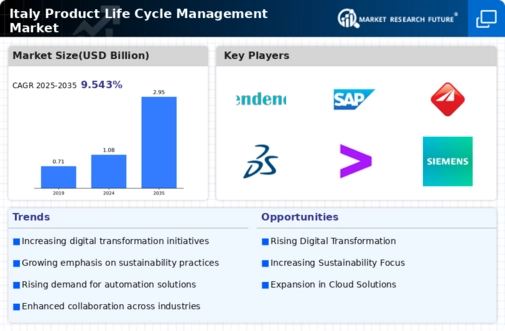Increased Investment in R&D
The product life-cycle management market is benefiting from heightened investments in research and development (R&D) across various industries. Companies are recognizing the importance of innovation in maintaining competitive advantage, leading to a surge in R&D expenditures. This trend is particularly evident in sectors such as fashion and technology, where rapid product development cycles are essential. Data indicates that R&D spending in these sectors has increased by approximately 10% over the past year, driving demand for PLM solutions that support efficient product development processes. As organizations seek to optimize their R&D efforts, the product life-cycle-management market is poised for growth, with a focus on integrating innovative practices.
Rising Demand for Customization
The product life-cycle management market is experiencing a notable shift towards customization, driven by consumer preferences for tailored products. As businesses strive to meet these demands, they are increasingly adopting product life-cycle management solutions that facilitate the design and development of customized offerings. This trend is reflected in the market data, which indicates that the customization segment is projected to grow at a CAGR of 8% over the next five years. Companies are leveraging advanced PLM tools to streamline processes, enhance product quality, and reduce time-to-market. This focus on customization not only improves customer satisfaction but also strengthens brand loyalty, thereby driving growth in the product life-cycle-management market.
Digital Transformation Initiatives
Digital transformation is reshaping the landscape of the product life-cycle-management market in Italy. Organizations are increasingly adopting digital tools and platforms to enhance their product development processes, improve collaboration, and streamline operations. The integration of digital technologies, such as cloud computing and IoT, is enabling companies to gather real-time data and insights, which are crucial for informed decision-making. Market data suggests that the digital transformation segment within the product life-cycle-management market is expected to grow by 7% annually, as businesses recognize the need to adapt to changing market dynamics and consumer expectations. This shift towards digitalization is likely to enhance overall efficiency and responsiveness.
Focus on Cost Reduction Strategies
Cost reduction remains a critical driver in the product life-cycle-management market in Italy. Companies are under constant pressure to optimize their operations and minimize expenses while maintaining product quality. As a result, many organizations are turning to PLM solutions to identify inefficiencies and streamline processes. The market data indicates that businesses implementing cost reduction strategies through PLM are achieving savings of up to 15% in operational costs. This focus on efficiency not only enhances profitability but also allows companies to allocate resources more effectively, thereby fostering growth in the product life-cycle-management market. The emphasis on cost management is likely to persist as competition intensifies.
Regulatory Compliance and Standards
In Italy, the product life-cycle-management market is significantly influenced by stringent regulatory requirements and industry standards. Companies are compelled to adopt PLM solutions to ensure compliance with local and international regulations, particularly in sectors such as pharmaceuticals and automotive. The need for traceability and documentation throughout the product life cycle is paramount, as non-compliance can result in substantial financial penalties. Market analysis suggests that the compliance-driven segment of the product life-cycle-management market is expected to expand by 6% annually, as organizations invest in technologies that enhance their ability to meet regulatory demands while maintaining operational efficiency.























Leave a Comment